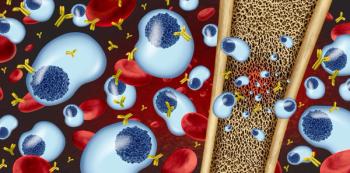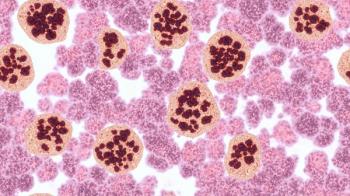
Hepatitis Awareness Month: Help Your Patients Live(r) Longer
Many of patients with hepatitis that pharmacists encounter have viral hepatitis, which can be easily remembered as the ABCs of hepatitis.
May is
As a result, providers may not be aware of unique pharmacotherapy requirements these patients may have. Prevention, optimal disease state management, and appropriate pharmacokinetic and therapeutic attention are all part of the holistic approach to hepatitis care.
Many of patients with hepatitis that pharmacists encounter have viral hepatitis, which can be easily remembered as the ABCs of hepatitis. Starting with the A for hepatitis A virus (HAV), the Centers for Disease Control and Prevention’s Division of Viral Hepatitis has noted an increasing number of HAV cases since March 2017.1
This is thought to be linked to imported foods that had been contaminated, causing primary infection continuing to spread from person-to-person. HAV infection can be prevented through a vaccine, good hygiene, and patients decreasing their risk factors.
Promoting the HAV vaccine to patients, especially those at high risk of HAV infection, can be arguably the best preventative measure to ensure a patient’s safety, as HAV can result in cholestatic hepatitis, relapsing hepatitis, autoimmune hepatitis or even liver disease. Just one dose of inactivated HAV vaccine can provide protection from HAV for up to 11 years.2,3
Risk factors for contracting HAV include illicit drug use, sexual contact with a person infected with HAV, contact with a person infected with HAV, homelessness, and travel to countries where HAV is prevalent including, Saudi Arabia, Syria, Turkey, and Eygpt.4 The spread of HAV can be reduced through good hand hygiene after using the restroom following contact with body fluids or stool, and through avoiding unsanitary food and water sources.5
The role of the pharmacist has been highlighted in various HAV outbreaks across the United States. Once such pharmacist, Dr. Monica Payne, a pharmacist from Section, Alabama, was on the front lines of fighting HAV in her community during an outbreak in 2019.
“The hepatitis A outbreak in 2019 was a trying time for our community, but it was also an excellent opportunity for pharmacists to show what we can do as the most accessible healthcare providers,” Payne said.
In late 2018, North Alabama, including Jackson County and Section, saw the start point of an outbreak that eventually made its way through the entire state by the end of 2020.6 Payne’s community pharmacy, Section Pharmacy, worked with the Alabama Department of Public Health to provide vaccine clinics in rural areas near Section where many patients did not have adequate transportation to a pharmacy or prescriber's clinic.
“We vaccinated hundreds of individuals across Jackson County to help control the outbreak, and we were proud to do our part in protecting the health of our community,” Payne said.
In contrast to HAV, there has been a steady decrease in hepatitis B virus (HBV) cases over the past 10 years. HBV prevalence has decreased in correlation with an increased vaccine prevalence. From 1999 to 2018, infection rates decreased from 5.7% to 4.3% with higher rates in men and non-Hispanic, Asian adults.
HBV can be contracted through sexual contact, contaminated blood, or be passed from mother to newborn. Due to this, vaccination was advocated for newborns and is correlated with today's decreased past and current cases of HBV.
It is important to continue to advocate for the HBV vaccine to all patients as severe complications can lead to cirrhosis, liver failure or kidney disease. During the years of 2015-2018, 25.2% of adults over 18 years of age had been vaccinated for HBV.7 Women had a higher prevalence of vaccination history, which would correlate with women having a lower prevalence for being infected.
These numbers and correlations of infections to vaccinations clearly depict a linear relationship of vaccinations lowering the number of infections and is why pharmacists should advocate for all patients to be fully vaccinated.7 A study published in 2020 showed clinically significant data that clinical pharmacists improved the attitude of patients living with HBV toward their infection and increased their knowledge about HBV through interviews.8
During these interviews the pharmacists elicited what the patient currently knew about the disease, corrected any misinformation, and then further educated them about HBV. After the interviews, patients indicated that their attitudes toward HBV had improved now that they had gained more knowledge about the disease.8
Also, as a rule, the better educated a patient is about their condition, the more likely they are to be adherent to their medication and non-pharmacological recommendations, improving patient outcomes.
Unlike HAV and HBV, hepatitis C virus (HCV) is more common in the United States. An estimated 2.4 million Americans are currently living with HCV.9
In 2018, a conservative estimate of 14,242 deaths in the United States were reported as a result of chronic HCV.10
Although this number continues to decline each year, pharmacists still need to promote the importance of risk reduction and frequent testing of those at high risk because complications of HCV can result in cirrhosis or liver cancer.
HCV is spread through contact with blood from an infected person and no vaccine is currently available for prevention. Pharmacists should encourage patients to get tested for HCV, because it often has no signs or symptoms and can lead to liver cancer if left untreated.
One population of high risk that pharmacists should recommend screening for are those born between the years 1946-1964, also known as the Baby Boomers. Risk reduction and early diagnosis are the best ways to increase the patient’s chances of a positive prognosis.
Talk with your peers about their comfortability level of performing point-of-care testing and providing basic education about HCV. A survey in 2019 was sent out to pharmacists in community settings that inquired about their comfortability level of performing point of care testing and patient education for HCV.
This survey concluded that the pharmacists surveyed were in support of the implementation of HCV point of care testing and that they would be willing to provide basic patient education.11 Having community pharmacists available for HCV testing could open the door for many patients who may feel more comfortable not going to a physician’s office and feel more comfortable with their pharmacist.
In the same mindset, National Hepatitis Testing Day is May 19. Use this day as an opportunity to discuss the importance of testing with patients to help protect themselves and others around them.5
One study illustrated the impact clinical pharmacists have on the outcomes of patients with HCV and HIV coinfections. The most notable roles the pharmacist played within the study included HCV medication adherence counseling, HCV drug-drug interaction counseling and screening, HCV medication counseling regarding common adverse events (AEs), HCV counseling regarding HCV treatment outcomes and risk of reinfection, ordering laboratory tests, and interpreting the HCV laboratory values.
The study was conducted to compare AEs and outcomes between groups of patients who had contact with a clinical pharmacist versus those who did not. The results were in favor of a clinical pharmacist’s expertise as part of a multidisciplinary care team to decrease AEs, increase favorable outcomes, and have better drug management for patients living with HCV/HIV coinfections.12
Studies such as these show the importance of pharmacists caring for patients with special pharmacokinetic indications, like hepatitis.
In addition to HAV, HBV, and HCV, there is also acute non-viral hepatitis. Acute non-viral hepatitis can stem from exposure to some medications, illegal drugs, alcohol overuse, and toxins.13
Some autoimmune diseases can also lead to acute hepatitis, especially when they go uncontrolled for a prolonged period of time.14 These autoimmune diseases include thyroiditis, type 1 diabetes, hemolytic anemia, and celiac disease.14
This illness results in inflammation of the liver that could progress to liver disease. In 2021, cases of acute non-viral hepatitis with unknown etiologies were suspected to have been derived from “Real Water” alkaline water, a brand that was recalled due to lack of compliance with the FDA.
Pharmacists can counsel patients to not consume products not approved by the FDA, help control any other comorbid conditions patients have, and to watch for signs and symptoms, such as fatigue, fever, abdominal pain, and joint pain.
Take time to educate patients on all-things hepatitis during the month of May. Educate patients on available vaccines, regular testing, and risk factors for contracting HAV, HBV, and HCV, as well as non-viral hepatitis.
Promote patient testing and immunizations, educate yourself on ways to promote hepatitis awareness, new testing procedures, and new treatment methods when available. Aside from educating patients, take the time to educate other health care professionals around you about the importance of hepatic dose adjustments for patients who have liver diseases.
It is instinct for many providers to double-check renal dose adjustments, but many may be unaware of the need for modifying the dose of drugs that are hepatic cleared to keep the patient safe and the drug at therapeutic concentrations. Overall, pharmacists hold a unique role in fighting hepatitis because of their extensive knowledge of pharmacokinetics and pharmacodynamics when treating hepatitis and preventing further liver damage.
Pharmacists are also the most easily accessible health care provider and can provide a safe and convenient space for patients to get tested and vaccinated against hepatitis.
References
- “Widespread Outbreaks of Hepatitis A Across the U.S.” Centers for Disease Control and Prevention, 2 May 2022, https://www.cdc.gov/hepatitis/outbreaks/2017March-HepatitisA.htm.
- Ott JJ, Wiersma ST. Single-dose administration of inactivated hepatitis A vaccination in the context of hepatitis A vaccine recommendations. Int J Infect Dis. 2013 Nov;17(11):e939-44. doi: 10.1016/j.ijid.2013.04.012. Epub 2013 Jun 21. PMID: 23791857.
- McMahon BJ, Beller M, Williams J, Schloss M, Tanttila H, Bulkow L. A program to control an outbreak of hepatitis A in Alaska by using an inactivated hepatitis A vaccine. Arch Pediatr Adolesc Med. 1996 Jul;150(7):733-9. PubMed PMID: 8673200.
- Ghasemian A. Prevalence of hepatitis A across various countries in the Middle East, African and Eastern European countries. Caspian J Intern Med. 2016;7(4):302-303.
- Centers for Disease Control and Prevention. (2022, March 30). What is hepatitis B - FAQ. Centers for Disease Control and Prevention. Retrieved April 7, 2022, from https://www.cdc.gov/hepatitis/hbv/bfaq.htm
- Alabama Hepatitis A Virus Outbreak. Alabama Public Health Immunization Division, 31 Mar. 2022, https://www.alabamapublichealth.gov/immunization/assets/hep_a_externalreport.pdf.
- Office of Infectious Disease and HIV/AIDS Policy (OIDP). (2021, July 9). Hepatitis awareness month (may). HHS.gov. Retrieved April 7, 2022, from https://www.hhs.gov/hepatitis/awareness-months-and-days/hepatitis-awareness-month-may/index.html
- Bahap, M., Kara, E., Cagla Sonmezer, M., Inkaya, A. C., Aydin-Hakli, D., Unal, S., & Demirkan, K. (2021). Pharmacist intervention to improve patients' knowledge and attitude towards hepatitis B infection. International journal of clinical practice, 75(4), e13952.
https://doi.org/10.1111/ijcp.13952 - Centers for Disease Control and Prevention. (2021, June 14). Learn more about hepatitis C and about getting tested. Centers for Disease Control and Prevention. Retrieved April 7, 2022, from https://www.cdc.gov/knowmorehepatitis/index.htm
- Centers for Disease Control and Prevention. (2021, May 14). Table 3.7 of 2019 Viral Hepatitis Surveillance Report. Centers for Disease Control and Prevention. Retrieved April 7, 2022, from https://www.cdc.gov/hepatitis/statistics/2019surveillance/Table3.7.htm
- So E, Brands M, Suomala E, et al. Pharmacists’ opinions on the implementation of HIV and hepc point-of-care-testing in a U.S. pharmacy chain. INNOVATIONS in pharmacy. 2019;10(1):10. doi:10.24926/iip.v10i1.1425
- Olea A Jr, Grochowski J, Luetkemeyer AF, Robb V, Saberi P. Role of a clinical pharmacist as part of a multidisciplinary care team in the treatment of HCV in patients living with HIV/HCV coinfection. Integr Pharm Res Pract. 2018;7:105-111. Published 2018 Aug 28. doi:10.2147/IPRP.S169282
- Centers for Disease Control and Prevention. (2021, November 23). Investigation of Acute Non-Viral Hepatitis of Unknown Etiology Potentially Associated with an Alkaline Water Product. Centers for Disease Control and Prevention. Retrieved May 3rd, 2022, from https://www.cdc.gov/knowmorehepatitis/index.htm
- “Autoimmune Hepatitis.” Johns Hopkins Medicine, 19 Apr. 2022, https://www.hopkinsmedicine.org/health/conditions-and-diseases/hepatitis/autoimmune-hepatitis.
Newsletter
Stay informed on drug updates, treatment guidelines, and pharmacy practice trends—subscribe to Pharmacy Times for weekly clinical insights.




















































































































































































































